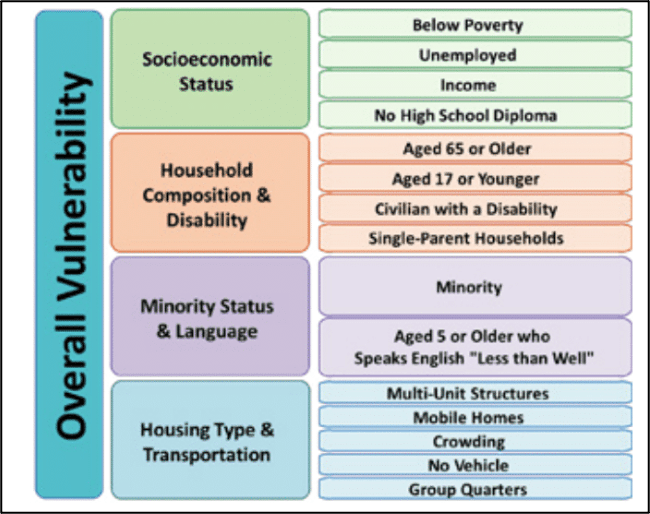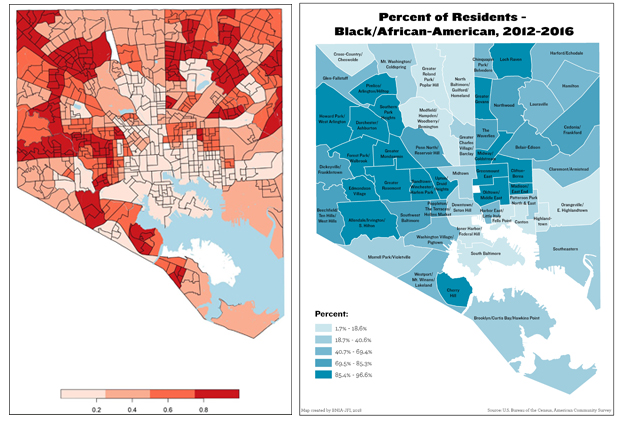Baltimore is failing to deliver quality transit to the predominantly low-income neighborhoods of color that need it most, a new report from public health researchers argues — and the analysis they used to identify those areas could serve as template for other cities committed to mobility justice, too.
In a bar-setting new report, a coalition of researchers from the Johns Hopkins Bloomberg School of Public Health and the Baltimore Transit Equity Coalition examined which Charm City neighborhoods are most in need of expanded and reliable transit service. But rather than look only at conventional measures of transit equity — like the number of stops within reach of the average resident, or the average commute time for bus riders — the team revealed a far more granular picture of the universe of public health metrics that expanded transit access can help improve.
The team painstakingly scored each of the 653 census block groups based on five separate indicators of air pollution, along with a raft of health indicators (such as rates of asthma, low birth weight, and COVID-19), and even a broad range of "Social Vulnerability Indicators" like access to affordable housing, disability status, household language access, and more. The highest overall scores indicated a neighborhood whose residents could potentially benefit the most from transit investment; neighborhoods with lower scores, by contrast, were doing relatively well.
Mapped out, the neighborhoods with the highest scores were almost identical to the neighborhoods in the footprint of Baltimore's "Black Butterfly," to quote the famous term coined by Dr. Lawrence Brown, where high concentrations of low-income, BIPOC residents have been pushed into a handful of neighborhoods, thanks to the enduring legacies of redlining and other forms of institutional racism. The areas with the least need, conversely, were located in Baltimore's "White L", the L-shaped land mass that runs along the city's harbor and central core, flanked by the butterfly's wings.
But even within the footprint of the Butterfly, researchers found 46 neighborhoods whose needs were particularly urgent — and in a city like Baltimore, where transit funding is scarce and a relatively high proportion of the city either relies on shared modes or struggles to meet the costs of car ownership, those differences matter..
"Ideally, we’d invest in all of the neighborhoods that have been historically redlined," said Dr. Megan Latshaw, associate scientist at Johns Hopkins and the lead author on the study. "But we don’t necessarily have the resources to do that. So if political leaders have to make tough decisions about where to invest, we want them to consider not just things like ridership and which communities are living within easy proximity of a bus stop, but also which communities have higher levels of negative health outcomes, in part because they don't have access to the reliable, efficient transit they need."
Maryland transportation planners don't exactly have a reputation for prioritizing historically disadvantaged neighborhoods. In 2015, Gov. Larry Hogan infamously cancelled a long-awaited light rail extension that would have connected the historically redlined areas across east and west Baltimore — in an ironic twist, it was actually called the Red Line — diverting $736 million in state funds to road-widening projects in the predominantly White surrounding counties and forcing the DOT to return nearly a billion dollars in federal grants in the process.
Even at the city level, Latshaw says local planners probably don't have access to the data they'd need to truly prioritize investment in the neighborhoods that are suffering the most.
"We don’t know much about how they analyze this stuff, because it’s not a very transparent process," she added. "But we do know they haven't done the level of analysis that we did. We know, for instance, that the last updates they made to transit in Baltimore looked at average distance to bus stops, but not at what we call origin-to-destination times, which is how long it actually takes you to get where you're going."
Latshaw says even her team's uniquely thorough analysis doesn't tell the whole whole story of what it's like to get around in Baltimore — because the public data they had access to didn't, either. Thanks to a paucity of meaningful metrics, the team was forced to omit stats on transit riders' exposure to traffic violence — a particularly critical measure in a city with some of the worst sidewalks in the nation — and also they couldn't account for levels of crime, police brutality, and other safety concerns. But she hopes future researchers will find creative ways to paint a more comprehensive picture in the future.
"We don't just want transit that gets people where they need to go in a short amount of time," she said. 'We also want them to get there safely — in every sense of the word."

Latshaw says making holistic safety and equity data easily available would go a long way towards integrating public health into the transit planning process. But in a perfect world, good metrics wouldn't just be easy to find — agencies would be required to reference them anytime they built something new, and face real consequences if they, for instance, decided to send millions in badly-needed urban transit funding to expand suburban highways.
Indeed, that possibility might become a reality if the Democrats succeed in passing their $3.5-trillion budget measure. The House Transportation and Infrastructure Committee's segment of the mega-bill included a $10-billion program specifically earmarked for improving the mobility of historically disadvantaged communities, which most advocates expect will be funneled primarily to transit.
But the big question is how, exactly, Washington will set parameters on which communities will qualify for the funds — a tricky analysis that Latshaw hopes public health researchers can help perform. And even if the budget measure fails, she hopes that the paper will inspire other advocates to push their transportation leaders to view transit planning through a public health lens, especially during the pandemic.
"It can't be repeated enough that the majority of people who we consider essential workers during this pandemic also rely on transit," Lathsaw said. "Whether it's hospital workers or grocery store employees, these are these people who we rely on to keep us moving forward as a society. Our system is failing them, but it doesn't have to."







